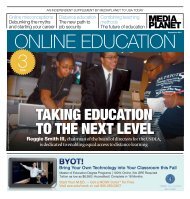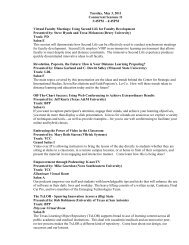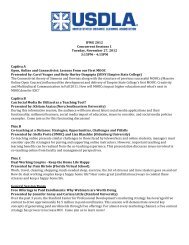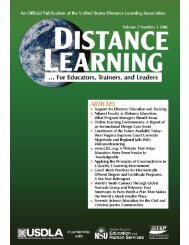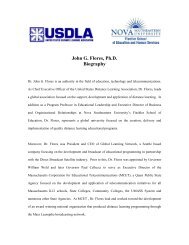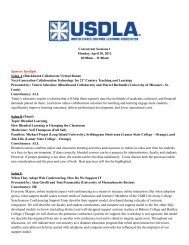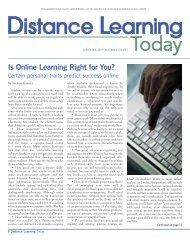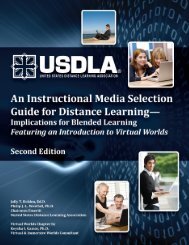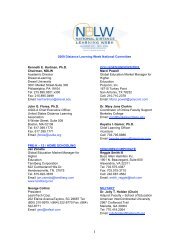United States Distance Learning Association
United States Distance Learning Association
United States Distance Learning Association
- No tags were found...
Create successful ePaper yourself
Turn your PDF publications into a flip-book with our unique Google optimized e-Paper software.
easoning as to how they are built, and you<br />
even know locations that you can retrieve<br />
them from; so now the question is, why use<br />
them at all One of the most difficult situations<br />
facing the education profession today<br />
is the fact that technology has almost created<br />
a demand for its usage and students<br />
are expecting the same type of technology<br />
in their classrooms as they get in everyday<br />
life. Music, videos, gaming, text messaging,<br />
e-mail—the list goes on and on, and these<br />
forms of technology are used every day in<br />
today’s society, and the education profession<br />
must be prepared to incorporate them<br />
into the learning environment. This is<br />
especially true in online education. Referring<br />
back to our beginning scenario of how<br />
online classes were first designed as nothing<br />
more than electronic textbooks, we<br />
realize that learning object usage will help<br />
engage the students and offer them an<br />
environment to learn in as opposed to one<br />
to learn from. Videos, audio notes, discussion<br />
boards, Web logs, and instant messaging<br />
can all be incorporated into an online<br />
course and will help keep the students<br />
engaged. Of course, to do all of this, the<br />
instructor must be able to use the technology<br />
and will have to use learning objects<br />
either that he or she has constructed or that<br />
he or she has pulled from a repository or<br />
other location. This is where a breakdown<br />
or a “choke point” is identified.<br />
Educational and training professionals<br />
must make time to learn technologies so<br />
they can take advantage of where this<br />
movement is taking the professions.<br />
Administrations must allow staff development<br />
time specifically for the technology<br />
training needed to enable their faculty and<br />
staff to acquire the knowledge and skill sets<br />
required to design and develop learning<br />
objects. In addition, the educators who grab<br />
hold of this movement now will be way<br />
ahead of the pack 3 or 4 years down the road<br />
when all courses face-to-face and distance<br />
are using learning objects as part of the<br />
everyday learning experience. On campus<br />
courses are becoming more hybridized and<br />
Web-enhanced, and are utilizing the same<br />
technologies that the online courses are<br />
using to deliver the content at a distance.<br />
This means that most of the faculty will need<br />
to know how to utilize, design, develop, and<br />
incorporate learning objects into their<br />
everyday lesson plans.<br />
<strong>Learning</strong> objects have become the new<br />
training aids of our day. They are a movement<br />
unto themselves. The only constant<br />
about learning objects is that they will continue<br />
to expand and evolve. They will be a<br />
part of the educational and training profession<br />
for as long as the digital revolution<br />
lasts and perhaps longer. For all we know,<br />
in the future, we’ll all be using telekinesis<br />
to download the information directly from<br />
the instructor’s to the student’s brain. Educators,<br />
trainers and administrators all need<br />
to prepare for the usage and expected<br />
involvement of learning objects both on<br />
campus and in distance education. The<br />
student of tomorrow will expect and<br />
demand technology usage in his or her<br />
learning experience, and educators and<br />
trainers will need to be prepared to meet<br />
their demand. That demand will be met by<br />
engaging and involving the students<br />
through the incorporation and usage of<br />
learning objects.<br />
REFERENCES<br />
<strong>Learning</strong> Object Metadata. (2005). Retrieved<br />
July 20, 2007, from http://ltsc.ieee.org/wg12/<br />
Multimedia Educational Resource for <strong>Learning</strong><br />
and Online Teaching. (2007). Retrieved July<br />
20, 2007, from http://www.merlot.org/merlot/<br />
index.htm<br />
Web Based Training Information Center. (2007).<br />
Retrieved July 20, 2007, from http://www<br />
.webbasedtraining.com/trends_ objects.aspx<br />
Wiley, D. (2000). The instructional use of learning<br />
objects. Retrieved July 20, 2007, from<br />
http://www.reusability.org/read/<br />
Wisconsin Online Resource Center. (2007).<br />
Retrieved on July 20, 2007, from http://<br />
www.wisc-online.com/<br />
Volume 4, Issue 4 <strong>Distance</strong> <strong>Learning</strong> 77



